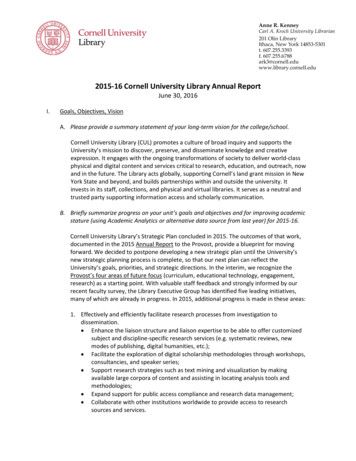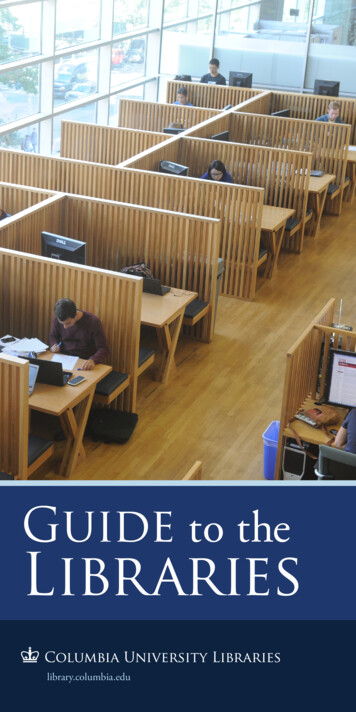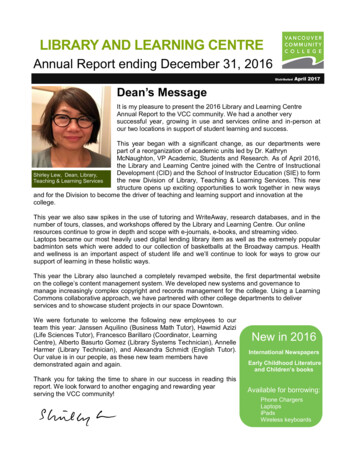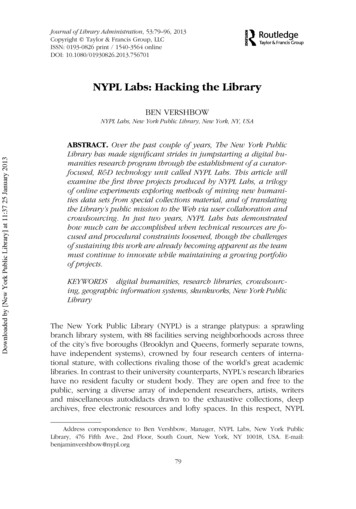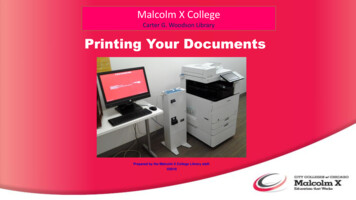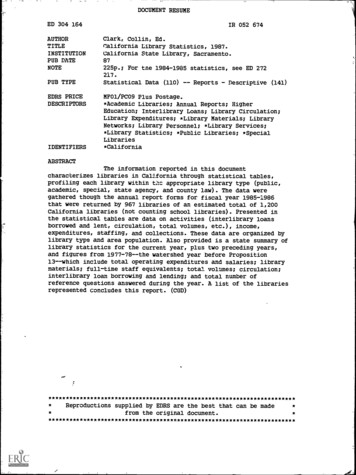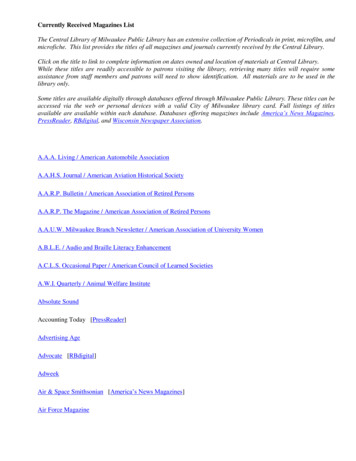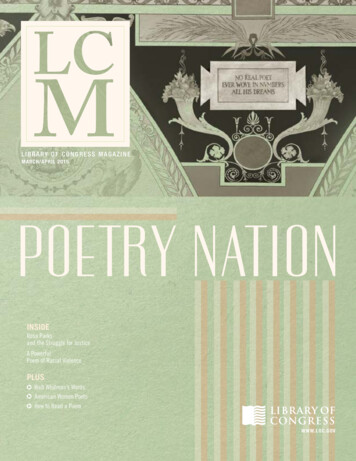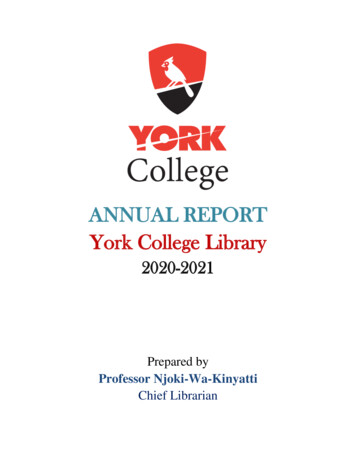
Transcription
ANNUAL REPORTYork College Library2020-2021Prepared byProfessor Njoki-Wa-KinyattiChief Librarian
August 2021ContentsIntroduction . 2I. Budget: Income and Expenditures . 3II. Reference Services . 5III. Cataloging . 7IV. Circulation and Reserve Services . 8V. CLICS (CUNY Libraries Inter-Campus Services) . 9VI. Electronic Resources . 9VII. Interlibrary Loan. 10VIII. Information Literacy . 10IX. Assessment . 11X. Computer Technology. 12XI. Academic Works . 13XII. Open Educational Resources . 14XIII. Archives . 14XIV. Major Challenges and Concerns . 14OTPS Budget for Collection Development . 15Funds for Lost Books . 15Library Security and Public Safety Coverage . 15XV. Library Faculty Scholarship & Creative Works, 2020-2021 . 16XVI. Library Faculty Service to the Department, College, and the University. 21XVII. Library Goals and Objectives . 23Academic Year 2020-2021 . 23York College Library Annual Report, 2020-2021Page 1
York College LibraryIntroductionYork College Library is a vital space for students’ academic success and remains the heart of thecollege. It is a place where students study, borrow materials, do their research, and completetheir assignments. Unfortunately, the COVID-19 pandemic impacted every aspect of our lives,including the way Library services were delivered to users. Consequently, with little time to planthe team worked diligently and swiftly transitioned to a distant learning model where all serviceswere accessed and delivered virtually; including chat reference, research consultations, andinformation literacy classes. Even though the physical space was not accessible due to pandemicrestrictions, the energetic team of faculty and staff remained resilient, worked diligently andmaintained continuous virtual research services. The Library personnel also made sure studentsand faculty were well informed of various resources that were virtually available, including ebooks, e-journals, and interlibrary loan articles. This experience of remote leaning and physicaldistancing provided us with new perspectives on how we connect and support each other as anacademic community. The Library department remains dedicated to supporting the educationalmission of York College by providing information literacy instruction, improving access toservices, and updating and expanding resources.During the past academic year (2020-2021), we expanded the Library’s access to virtualresources by purchasing 645 e-books and converting physical course reserves to e-reserves,making it possible for students to access these materials remotely. We will continue to explorenew ways to facilitate these connections with the goal of creating meaningful memories whilealso achieving academic success. Every academic year presents me with an opportunity toanalyze my goals, including how I can better advocate for faculty and students in order toprovide them with the essential resources and research services they deserve. Improving theservices, the library provides to our users occupies a great deal of my time. As a department, weare committed to being inclusive of the expectations of all users and equitably support theresearch needs of every academic program and discipline.I am especially grateful to the support from Interim Provost, Dr. Derrick Brazill. The LibraryDepartment appreciates the continued support from Mr. Ismael Perez, Assistant Vice Presidentfor Planning and Budget, and the entire staff of the Budget Office for their support. The Librarywould also like to thank Mr. Claudio Lindow, Interim Chief Information Officer and his team fortheir continued support.York College Library Annual Report, 2020-2021Page 2
I. Budget: Income and Expenditures(Statistics Provided by Professor John Drobnicki, Head of Acquisitions & CollectionDevelopment)Note: Budget report was prepared by Professor Njoki Kinyatti, Chief Librarian.The Library’s primary budget source is OTPS (Other Than Personnel Services) tax-levy funds.Supplementary sources of funding include the Technology Fee (15%), and Auxiliary Enterprises(15 cents of every dollar spent by customers who use cash to print or copy in the Library). Inaddition, the 2005 agreement between the New York City Department of Education (NYCDOE)and the City University of New York (CUNY) stipulates that, all CUNY libraries with anaffiliated high school receive an amount per high school student based on the previous year’sSchool-Based Expenditure Report. The Library also received a generous fund from OpenEducation Resources (OER) grant. Thank you to Dr. Greet Van Belle for collaborating with theLibrary.Tables 1 and 2 show a breakdown of the Library’s income receivables and expenditures for2020-2021.Table 1: Summary of the Library’s Income Receivables from July 2020-June 2021Funding SourceIncomeOTPS 70054 58,156.00Tech Fee 262,938.76High School Funds 43,280.00Social Work (MSW) Gift 5,500.00Auxiliary Enterprise & Foundation 24,650.93Open Education Resources Grant (OER) 11,000.00Total Income for Academic Year 2020-2021 405,525.69The total annual expenditures for academic year 2020-2021 were 398,789 a reduction of 35,993 when compared to 2019-2020 total expenditures of 434,782. Unfortunately, whencompared with 2018-2019 expenditures of 437,266, there is a significant difference of 38,477.During 2020-2021, the Library spent 80,513.24 on print materials, e-books, and databases. It isimperative to point out that of the 80,513 that was allocated for collection development andadditional databases, 43,278.67 came from High School funds, 10,275.99 Auxiliary funds, and 5,500 from the Social Work Department. Therefore, the Library’s OTPS budget for collectiondevelopment was in reality only 24,997.05, an allocation that is hardly enough to acquireresources for two graduate programs, let alone York's six existing graduate programs.York College Library Annual Report, 2020-2021Page 3
The continuous reduction of the Library’s OTPS budget for collection development has notenabled us to keep our collection up-to-date and on par with other CUNY libraries, including thesupport that additional graduate programs require. If this decline of OTPS budget is notaddressed immediately, York College Library’s collection will continue to become antiquated,and consequently, fail to support the academic success for both undergraduate and graduatestudents or meet any faculty research needs. At present, York College is offering six mastersprograms (Physician Assistant, Social Work, Pharmaceutical Science and Business, Aviation,Clinical Trials Management, and Occupational Therapy). Moving forward, it is critical that theYork College Budget Office allocates adequate funds for collection development when planningfor the expansion of programs offered, especially graduate programs that require access toresearch beyond general studies. In order for York College to successfully compete with othercolleges that offer similar programs, the administration must be prepared to fund access to theresources necessary for our students and faculty to demonstrate currency in these advancedfields. Since York College continues to expand its graduate programs, it is necessary that thebudget for resources be annually evaluated and increased before the Library reaches a breakingpoint. While the Library remains fully committed to supporting students and fellow faculty byproviding access to the resources and services required by all academic programs and disciplines,this continued decline in the collection development budget will have serious implications forproviding effective research support. This lack of adequate support in addition to an obsoletecollection could in turn have a negative impact on York College’s retention rates.Table 2: Summary of Library’s Expenditures, AY 2020-2021Description of ExpendituresAmount SpentElectronic ResourcesBooks (Print)EbooksSerialsCataloging*Interlibrary LoanConsortium MembershipCataloging suppliesContractual Services (Bibliotheca, LLC)CCP Solution Scanner ContractDR 111, Company Scanner ContractLibrary FurnitureOER ExpenditureGrand Total of Annual Expenditures 262,938.76 4,024.93 76,488.31 31,277.31 541.59 2,554.05 2,202.00 570.00 3,715.36 1,300.00 450.00 1,879.15 10,848.00 398,789.46*Includes 35 invoice paid for lost ILL book. (Figures are rounded to the nearest whole number)York College Library Annual Report, 2020-2021Page 4
Table 3: Book Purchasing Summaries by Vendor and Budget Source, AY 2020-2021Fund Source - VendorAmount SpentAuxiliary funds - COUTTS 10,275.99High School funds - COUTTS 43,278.67OTPS funds - COUTTS 24,997.05Social Work Funds -COUTTS ,961.53 80,513.24Total Amount Spent*Auxiliary funds consisted of CCDA grant money from the New York State Library.Social Work funds were transferred to the Library by the Social Work Department; most of thefunds were spent on database subscriptions, and the remaining amount was spent on e-books.NOTE: Expenditure figures for the Library’s Office and Book Supplies, Contractual Services,& Equipment were provided by Mrs. Vickitoy Meyers, CUNY Office Assistant and the Library’sSecretary.Unspent Funds:AccountAuxiliary fundsHigh School fundsOTPS fundsSerialsSocial Work fundsTotal Amount Unspent Amount Unspent 4.01 1.33 2.95 0.25 4.47 13.01New books ordered and received during FY21:CategoryPrint booksEbooksTotal Added to collection *Includes standing orders.Number83645728II. Reference Services(Statistics Compiled by Professor Todd Simpson Head of Reference Services and Queens HighSchool for the Sciences at York College).Reference services are provided as a coordinated effort by all department faculty with the goal toconnect library patrons to the most relevant information available to satisfy their researchinterests. At York, Reference services have historically been provided by appointment, email,phone, and face-to-face at the Reference desk all hours of operation while class is in session andYork College Library Annual Report, 2020-2021Page 5
on an on-call basis when class is not in session. With the onset of the pandemic in the springsemester of 2020 how these services were provided had to drastically change and the Libraryresponded by redesigning the website and expanding an existing license for the Springshare suiteof products, affording us the ability to answer questions through a live chat service. By the timethe 2020-2021 academic year began we had expanded this service so that it was accessible onevery page of the Library website and embedded into a significant number of databases. Thefunctionality of the chats themselves were expanded to include screensharing capabilityaffording librarians the ability to directly demonstrate how to navigate Library resources. Howthe Library collected reference statistics radically changed alongside the platform through whichour services were provided. This, in addition to the fact that throughout the entire 2020-2021academic year the York academic community was limited to remote learning modalities and willhopefully be a stand-alone experience as the pandemic subsides in the year to come, means thatthe statistics will not be a one-to-one comparison to prior or future years.For the immediate future, Reference services will continue to be provided online and remotelyuntil face-to-face services become safe again. That said, these new online services will notdisappear as we return to on-site services in the future. In fact, the Library is currently exploringways to expand the online chat service with the hopes that it will soon be available to patrons 24hours a day. While students have always been able to request research consultations, the need tomake this service more explicitly accessible to students who were confined to remote learningwas readily apparent. The Library addressed this need by adding a request form for individualresearch consultations on the website. In the 2019-2020 academic year, librarians met with 20scholars for pre-arranged research consultations. In the 2020-2021 academic year, librariansprovided 64 pre-arranged individual research consultations lasting more than 15-minutes, a morethan three-fold increase. Librarians responded to 301 emails sent to the reference account.Librarians completed 1,223 individual chat sessions throughout the 2020-2021 academic yearwith July 2020 our slowest month (11 chat sessions) and February 2021 being our busiest month(177 chat sessions):These numbers refer specifically to reference interactions with librarians and do not include chatinteractions with circulation staff. Librarians were available online via the chat service Mondaythrough Saturday, with Mondays and Tuesdays being the busiest days:York College Library Annual Report, 2020-2021Page 6
During fall and spring semesters of the 2020-2021 academic year, librarians were availableonline from 9am to 9pm Monday through Thursday, 9am to 6pm on Fridays, and 9am to 5pm onSaturdays. The 11am to 4pm hours were our busiest times, however the hourly breakdowndemonstrates a consistently used service and we feel demonstrates the need for expanding thehours that chat is available for patrons:III. Cataloging(Data Provided by Professor Junli Diao, Head of Cataloging and Serials)CUNY accomplished the system platform transition from Aleph to Alma during the time ofCOVID-19. All cataloging professionals worked remotely at home in the new, cloud-basedcataloging environment. Physical materials were not able to be taken back home for processingand cataloging. Hence, mastering how cataloging was performed in the new platform Almabecame the top priority of cataloging work. Junli Diao, Assistant Professor/Head of Cataloging& Serials, actively engaged in Alma cataloging optimization projects and Alma data review. HeYork College Library Annual Report, 2020-2021Page 7
also participated in the train-the-trainers project and then provided Alma cataloging training toCUNY cataloging professionals. Lesly Previl, CUNY Office Assistant, attended the requiredtraining sessions related to cataloging and serials. After migration, Diao attended monthlyCUNY Cataloging Committee Meetings (six sessions) and Cataloging Monthly Drop-Ins (sixsessions) for informal discussion of Alma a questions and concerns. Diao also represented Yorkat the Alma Advisor Committee (five sessions) and worked as a member of the Alma AdvisorySub-group to review the monthly release notes (four sessions). In addition, Diao attended LSPMetadata Working Group meetings and assisted Marsha Clark in preparing Alma catalogingpolicies. In sum, cataloging professionals devoted to virtual professional activities during thepandemic and carried necessary, essential, value-added enhancement tasks in Alma.IV. Circulation and Reserve Services(Statistics Provided by Mrs. Grace Avila, Manager of Circulation & Reserve Services)Table 6: Number of Circulation and Reserve Transactions, July 2016-June 2021Academic YearTotal Items 2017-2018110,2662016-2017124,812The Library’s circulation and reserve services had restructured its services due to the transitionfrom face-to-face to remote services during the COVID-19 crisis. To engage users, thecirculation and reserve collection is undergoing transition to offer digitalization services users.628 new course records were created to reflect all courses offered in Fall 2021. 110 of the 628course records have been updated with current reserve materials. More than 25 records haveactive title links to their e-book titles within the Library’s collection. College Assistants hasbeen trained to update course reserve records and are continually participating in updatingrecords, monitoring circulation chat traffic, and the Library staff email. The informationcollecting system for reserve materials has been replaced with an easy access online "coursereserve request" form. No study room reservations and tablet loans statistics as the libraryremains physically closed to users.”In addition, circulation now assists in Interlibrary loan duties by verifying the status of patronswho request Interlibrary loan services. During the past academic year, College Assistants weretrained how to use CUNY-wide Alma circulation system. Alma uses the term fulfillment in placeof circulation and among the circulation (Fulfillment) staff we now use Fulfillment with eachother. However, since fulfillment is a form of Library jargon and circulation is what the generalpublic uses and understands we will continue to use the term circulation with the public. Once,CUNY's libraries' have reopened we will learn how to use Alma for CUNY-wide interlibraryloan and will need to come up with a system to retrieve books from the stacks for patrons oncampus. For that we will use PRIMO, Alma's online public catalog system."York College Library Annual Report, 2020-2021Page 8
V. CLICS (CUNY Libraries Inter-Campus Services)(Statistics Provided by Mr. Travis Hilton, CUNY Office Assistant, Circulation and ReserveServices)NOTE: During the academic year 2020-2021, there were no statistics for CLICS. This servicewas suspended university-wide due to COVID-19 pandemic.VI. Electronic Resources(Prepared by Professor Meredith Powers, Coordinator of Electronic Resources)For the academic year 2020-2021, the Library spent 262,938.76 in Technology Fee funds onelectronic resources for students. This represents a slight decrease from last year’s expenditure.The Library had cancelled subscriptions to several underutilized resources over the past fewyears, and allocated the funds towards other continuing resources and new e-book collections.Other savings come from careful negotiations to keep database renewal increases low.Thanks to the generous allocation of Technology Fee funds, the Library was again able tomaintain its commitment to STEM resources, which were negotiated by the CUNY Office ofLibrary Services (OLS) to secure access to high-quality resources for science, technology,engineering, and mathematics. York Library’s contribution to the STEM initiative totaled 98,053.44. While we do expect this number to increase in future years, this year remained lowbecause publishers and database vendors kept their usual increase rates flat for the most part, dueto the ongoing pandemic.This collection is one of the Library’s most-used resources to date, andwe look forward to continuing this CUNY-wide initiative in the future.More than ever, the Library relied heavily on electronic subscriptions and services this year inorder to best support students and faculty engaged in distance learning. We worked with theCUNY Office of Library Services (OLS) and other CUNY libraries to streamline, upgrade, andconsolidate our chat reference services. At York, we maintained continuous, uninterruptedreference services and expanded our online capabilities. Students and faculty benefited from ourearly jump into virtual library services, and over the past year we were able to advocate for thechat service with CUNY OLS, such that chat reference will cost us even less moving forward.Similarly, we were able to expand our recent video collection, Alexander Street Academic VideoOnline, by advocating for a CUNY-wide subscription. As a result, York will pay less for thesame content in the next year. We have also continued to grow our evidence-based e-booksubscription option through Wiley Online Library, as well as purchased new e-books for ourpermanent collection, including titles in arts & humanities, business, health, history, literature,medicine, science, and social work.Finally, thanks to a generous donation of funds from the Social Work department, we were ableto expand our support for the MSW program by acquiring e-books, textbooks and two newfocused databases, Social Work Reference Center and Social Work Online.York College Library Annual Report, 2020-2021Page 9
VII. Interlibrary Loan(Prepared by Professor Di Su, Head of Interlibrary Loan)Table 7: Interlibrary Loan Requests, AY Filled Requests1860186Table 8: Total Filled Requests, Historical Comparison, 2016-2021Academic 41Note: Interlibrary Loan print book service was suspended in March 2020 due to COVID-19pandemic. On the other hand, compared with last year, the number of article requests jumpedmore than 100% because articles were processed and delivered electronically.During the academic year 2020-21, we had 97 registered users.The top three departments that had the most requests were; Chemistry, English, and Library.VIII. Information Literacy(Prepared by Professor Di Su, Head of Information Literacy)Table 9: Library Instruction Sessions, AY 2020-2021Month / Year / SemesterNumber of SessionsJuly 20202Number of r12261December00York College Library Annual Report, 2020-2021Page 10
January al591,338Table 10: Historical IL Session Statistics, 2016-2021Academic YearNumber of IL SessionsNumber of 1232,8002017-20181523,7822016-20171413,284Note: Since March 2020 the physical campus was closed because of the COVID-19 pandemic.For the first time, all Information Literacy classes were taught online for the entire academicyear. However, not all course instructors were ready for the change. As a result, the number ofclasses dropped more than 50%. We used three online communication platforms depending onthe course instructor’s classroom setting: WebEx, Blackboard Collaborative Ultra, and Zoom.IX. Assessment(Prepared by Professor Di Su, Library’s Assessment Coordinator)In collaboration with Biology Department we completed Information Literacy tests for thelibrary program assessment in fall 2020.Sample SizeCourse: Bio 201, n 168 pre-tests, n 124 post-tests. There were ten Bio 201 classes in fall 2020and we tested all of them.Findings and ProgressThe full score is 20. Our goal, stated in 2020 Assessment Plan, was to achieve 70% of correctanswers in the post tests. 70% of 20 is 14. The pre-tests (before the IL session) had 168 students,the mean score was 12.123. The post-tests (after the IL session) had 124 students, the mean scorewas 14.248. The result is over 14, thus, the 70% goal was achieved.York College Library Annual Report, 2020-2021Page 11
X. Computer Technology(Statistics Provided by Mr. Jahed Sarwar, Library Systems Administrator)The York College Library's IT project was halted due to the global pandemic. Library CLT andIT Staff reviewed system requirements with vendors in the spring of 2020, including thereplacement of old copiers with new ones equipped with advanced technology copiers and theinstallation of the new Pay Station with Payment Gateway Connector. Simultaneously, LibraryCLT also worked with the IT department to refresh 18 Lenovo ThinkPad T430 laptops, so thatthey are available for students’ loan in fall 2021.In comparison to the previous academic year, the "Available Library Computers" and "PublicSpace Technology" tables are unchanged since the campus is closed due to the Pandemic. Thelibrary expects all ongoing technology projects to be completed next academic year.For the academic year 2020-2021, York College & Library is offering the following resourcesfor distance learning and remote working. Remote Access Services—from home or abroad is available to campus resources viaVPN and remote desktop.VPN Access—A Virtual Private Network (VPN) provides an encrypted connectionbetween your off-campus computer and the YC campus network; Access to Librarydatabases and network share files.CUNY Virtual Desktop— you can access your course software remotely from anylocation.Cisco Webex— faculty and staff to help with online learning and meetings.Zoom Meetings— allow faculty and staff to host or participate in online Zoom meetingsby telephone, mobile device, or computer.Microsoft Teams— is unified communication and collaboration platform that offerschat, video conferencing, file storage, and app integration.GlobalProtect—is the system used to connect to the Virtual Private Network (VPN) atYork College. A VPN provides an encrypted connection between your off-campuscomputer and the campus network.HR Assist (Employee Management System) — Timesheets are now online. Faculty andstaff can use VPN connectivity to log in and out of the HR Assist program, request ALpersonal leave, etc.B&G Work Order System— CUNY-Wide's B&G Work Order System is an internetbased system to coordinate work orders and space management.Table 11: Available Library Computers, July 2016-June 2021AcademicYearDesktop PCs(ClassroomLab)2020-202131Desktop PCs(Public Space)219York College Library Annual Report, 2020-2021LaptopsSurfaceTabletsTotal1820288Page 12
83113918202082016-2017311391820208Before the pandemic, Microfilm's workstations ran Windows 10 and were completed by thevendor's service in spring 2020. Once again, the scanner in use was fully functional. Two copiersand 20 computers were borrowed by the Library's IT department, which will return them whenthe Library service resumes.Table 12: Public Space Technology July 2016-June 2021Academic Year Scanners PrintersCopiersPay -2019577212017-2018577212016-201727621Last but not least, library faculty and staff are requesting the installation of webcams andmicrophones at their office’s workstations in order to facilitate online teaching and meetings.The project is also expected to be completed in the fall of 2021.XI. Academic Works(Prepared by Professor Stefka Tzanova, Science Librarian & Coordinator of Academic Works)Academic Works is the CUNY open access institutional repository created and maintained bythe Office of Library Services (OLS) in accordance with CUNY’s mission as a public universityto provide free access to faculty scholarship in various formats (journal articles, book chapters,conference papers, presentations, and other creative works). Academic Works operates on a selfsubmission model and provides a permanent URL for the submitted work, ensuring stable, long–term access making the work more discoverable by major search engines and contributing toincreased citation rates. The York College section of Academic Works includes three series;Archives, Publications and Research, and Open Educational Resources (OER). The Archivalseries is currently comprised of digitized copies of the award-winning official students’newspaper Pandora’s Box. The Publications and Research series includes total of 293publications by York faculty compared to 261 publications last year. The OER series, launchedYork College Library Annual Report, 2020-2021Page 13
in 2019 with one submission, nowadays includes total of 26 submissions (lesson plans, syllabi,active learning assignments, and video lectures) by York faculty.XII. Open Educational Resources(Prepared by Professor Stefka Tzanova, Coordinator of Open Educational Resources)OERs (Open Educational Resources) are any resources available at little or no cost that can beused for teaching, learning, or research, including but not limited to textbooks, course readings,syllabi, quizzes, and virtually any other material that can be used for educational purposes. Whiletraining York faculty to convert OER courses last year we faced challenges, including skepticismtowards OER; because not all disciplines and courses are equally suited to OER conversion. Inorder to provide high quality teaching materials and to keep up with the OER initiative, theLibrary took the next step - complementing the free educational materials with copyrightedcontent (books and e-books,
Social Work Funds -COUTTS ,961.53 Total Amount Spent *Auxiliary funds consisted of CCDA grant money from the New York State Library. Social Work funds were transferred to the Library by the Social Work Department; most of the funds were spent on database subscriptions, and the remaining amount was spent on e-books.


